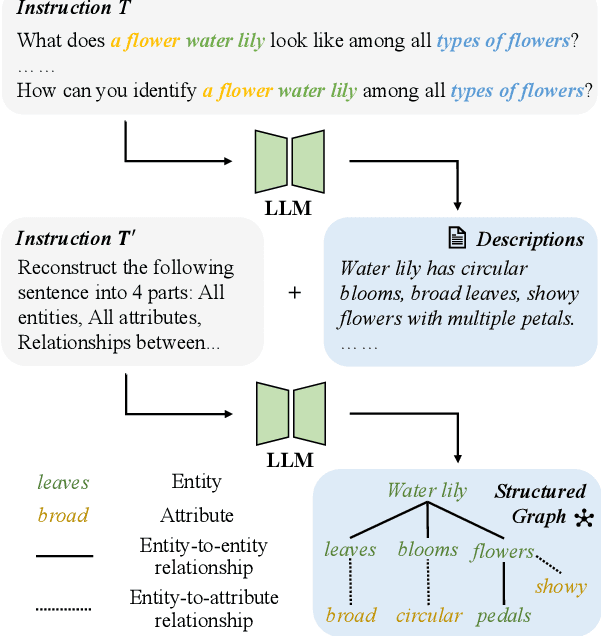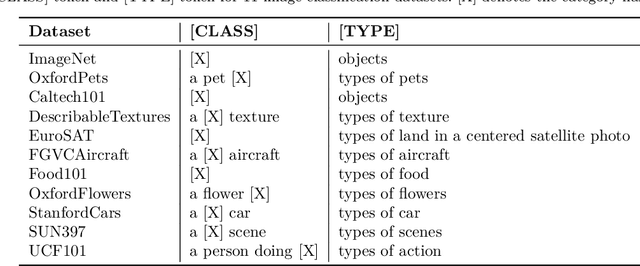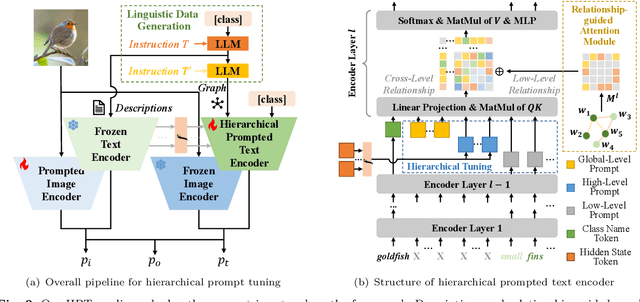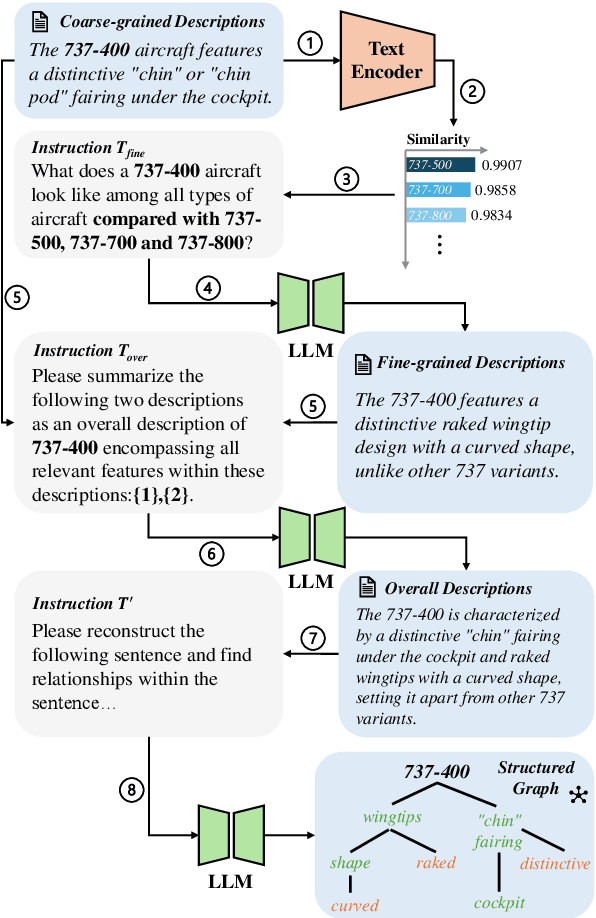De Cheng
Multi-level Collaborative Distillation Meets Global Workspace Model: A Unified Framework for OCIL
Aug 12, 2025Abstract:Online Class-Incremental Learning (OCIL) enables models to learn continuously from non-i.i.d. data streams and samples of the data streams can be seen only once, making it more suitable for real-world scenarios compared to offline learning. However, OCIL faces two key challenges: maintaining model stability under strict memory constraints and ensuring adaptability to new tasks. Under stricter memory constraints, current replay-based methods are less effective. While ensemble methods improve adaptability (plasticity), they often struggle with stability. To overcome these challenges, we propose a novel approach that enhances ensemble learning through a Global Workspace Model (GWM)-a shared, implicit memory that guides the learning of multiple student models. The GWM is formed by fusing the parameters of all students within each training batch, capturing the historical learning trajectory and serving as a dynamic anchor for knowledge consolidation. This fused model is then redistributed periodically to the students to stabilize learning and promote cross-task consistency. In addition, we introduce a multi-level collaborative distillation mechanism. This approach enforces peer-to-peer consistency among students and preserves historical knowledge by aligning each student with the GWM. As a result, student models remain adaptable to new tasks while maintaining previously learned knowledge, striking a better balance between stability and plasticity. Extensive experiments on three standard OCIL benchmarks show that our method delivers significant performance improvement for several OCIL models across various memory budgets.
Prompt Disentanglement via Language Guidance and Representation Alignment for Domain Generalization
Jul 03, 2025Abstract:Domain Generalization (DG) seeks to develop a versatile model capable of performing effectively on unseen target domains. Notably, recent advances in pre-trained Visual Foundation Models (VFMs), such as CLIP, have demonstrated considerable potential in enhancing the generalization capabilities of deep learning models. Despite the increasing attention toward VFM-based domain prompt tuning within DG, the effective design of prompts capable of disentangling invariant features across diverse domains remains a critical challenge. In this paper, we propose addressing this challenge by leveraging the controllable and flexible language prompt of the VFM. Noting that the text modality of VFMs is naturally easier to disentangle, we introduce a novel framework for text feature-guided visual prompt tuning. This framework first automatically disentangles the text prompt using a large language model (LLM) and then learns domain-invariant visual representation guided by the disentangled text feature. However, relying solely on language to guide visual feature disentanglement has limitations, as visual features can sometimes be too complex or nuanced to be fully captured by descriptive text. To address this, we introduce Worst Explicit Representation Alignment (WERA), which extends text-guided visual prompts by incorporating an additional set of abstract prompts. These prompts enhance source domain diversity through stylized image augmentations, while alignment constraints ensure that visual representations remain consistent across both the original and augmented distributions. Experiments conducted on major DG datasets, including PACS, VLCS, OfficeHome, DomainNet, and TerraInc, demonstrate that our proposed method outperforms state-of-the-art DG methods.
EKPC: Elastic Knowledge Preservation and Compensation for Class-Incremental Learning
Jun 14, 2025Abstract:Class-Incremental Learning (CIL) aims to enable AI models to continuously learn from sequentially arriving data of different classes over time while retaining previously acquired knowledge. Recently, Parameter-Efficient Fine-Tuning (PEFT) methods, like prompt pool-based approaches and adapter tuning, have shown great attraction in CIL. However, these methods either introduce additional parameters that increase memory usage, or rely on rigid regularization techniques which reduce forgetting but compromise model flexibility. To overcome these limitations, we propose the Elastic Knowledge Preservation and Compensation (EKPC) method, integrating Importance-aware Parameter Regularization (IPR) and Trainable Semantic Drift Compensation (TSDC) for CIL. Specifically, the IPR method assesses the sensitivity of network parameters to prior tasks using a novel parameter-importance algorithm. It then selectively constrains updates within the shared adapter according to these importance values, thereby preserving previously acquired knowledge while maintaining the model's flexibility. However, it still exhibits slight semantic differences in previous knowledge to accommodate new incremental tasks, leading to decision boundaries confusion in classifier. To eliminate this confusion, TSDC trains a unified classifier by compensating prototypes with trainable semantic drift. Extensive experiments on five CIL benchmarks demonstrate the effectiveness of the proposed method, showing superior performances to existing state-of-the-art methods.
StPR: Spatiotemporal Preservation and Routing for Exemplar-Free Video Class-Incremental Learning
May 20, 2025Abstract:Video Class-Incremental Learning (VCIL) seeks to develop models that continuously learn new action categories over time without forgetting previously acquired knowledge. Unlike traditional Class-Incremental Learning (CIL), VCIL introduces the added complexity of spatiotemporal structures, making it particularly challenging to mitigate catastrophic forgetting while effectively capturing both frame-shared semantics and temporal dynamics. Existing approaches either rely on exemplar rehearsal, raising concerns over memory and privacy, or adapt static image-based methods that neglect temporal modeling. To address these limitations, we propose Spatiotemporal Preservation and Routing (StPR), a unified and exemplar-free VCIL framework that explicitly disentangles and preserves spatiotemporal information. First, we introduce Frame-Shared Semantics Distillation (FSSD), which identifies semantically stable and meaningful channels by jointly considering semantic sensitivity and classification contribution. These important semantic channels are selectively regularized to maintain prior knowledge while allowing for adaptation. Second, we design a Temporal Decomposition-based Mixture-of-Experts (TD-MoE), which dynamically routes task-specific experts based on their temporal dynamics, enabling inference without task ID or stored exemplars. Together, StPR effectively leverages spatial semantics and temporal dynamics, achieving a unified, exemplar-free VCIL framework. Extensive experiments on UCF101, HMDB51, and Kinetics400 show that our method outperforms existing baselines while offering improved interpretability and efficiency in VCIL. Code is available in the supplementary materials.
Semantic-Aligned Learning with Collaborative Refinement for Unsupervised VI-ReID
Apr 27, 2025Abstract:Unsupervised visible-infrared person re-identification (USL-VI-ReID) seeks to match pedestrian images of the same individual across different modalities without human annotations for model learning. Previous methods unify pseudo-labels of cross-modality images through label association algorithms and then design contrastive learning framework for global feature learning. However, these methods overlook the cross-modality variations in feature representation and pseudo-label distributions brought by fine-grained patterns. This insight results in insufficient modality-shared learning when only global features are optimized. To address this issue, we propose a Semantic-Aligned Learning with Collaborative Refinement (SALCR) framework, which builds up optimization objective for specific fine-grained patterns emphasized by each modality, thereby achieving complementary alignment between the label distributions of different modalities. Specifically, we first introduce a Dual Association with Global Learning (DAGI) module to unify the pseudo-labels of cross-modality instances in a bi-directional manner. Afterward, a Fine-Grained Semantic-Aligned Learning (FGSAL) module is carried out to explore part-level semantic-aligned patterns emphasized by each modality from cross-modality instances. Optimization objective is then formulated based on the semantic-aligned features and their corresponding label space. To alleviate the side-effects arising from noisy pseudo-labels, we propose a Global-Part Collaborative Refinement (GPCR) module to mine reliable positive sample sets for the global and part features dynamically and optimize the inter-instance relationships. Extensive experiments demonstrate the effectiveness of the proposed method, which achieves superior performances to state-of-the-art methods. Our code is available at \href{https://github.com/FranklinLingfeng/code-for-SALCR}.
Exploring Interpretability for Visual Prompt Tuning with Hierarchical Concepts
Mar 08, 2025Abstract:Visual prompt tuning offers significant advantages for adapting pre-trained visual foundation models to specific tasks. However, current research provides limited insight into the interpretability of this approach, which is essential for enhancing AI reliability and enabling AI-driven knowledge discovery. In this paper, rather than learning abstract prompt embeddings, we propose the first framework, named Interpretable Visual Prompt Tuning (IVPT), to explore interpretability for visual prompts, by introducing hierarchical concept prototypes. Specifically, visual prompts are linked to human-understandable semantic concepts, represented as a set of category-agnostic prototypes, each corresponding to a specific region of the image. Then, IVPT aggregates features from these regions to generate interpretable prompts, which are structured hierarchically to explain visual prompts at different granularities. Comprehensive qualitative and quantitative evaluations on fine-grained classification benchmarks show its superior interpretability and performance over conventional visual prompt tuning methods and existing interpretable methods.
Demystifying Catastrophic Forgetting in Two-Stage Incremental Object Detector
Feb 08, 2025Abstract:Catastrophic forgetting is a critical chanllenge for incremental object detection (IOD). Most existing methods treat the detector monolithically, relying on instance replay or knowledge distillation without analyzing component-specific forgetting. Through dissection of Faster R-CNN, we reveal a key insight: Catastrophic forgetting is predominantly localized to the RoI Head classifier, while regressors retain robustness across incremental stages. This finding challenges conventional assumptions, motivating us to develop a framework termed NSGP-RePRE. Regional Prototype Replay (RePRE) mitigates classifier forgetting via replay of two types of prototypes: coarse prototypes represent class-wise semantic centers of RoI features, while fine-grained prototypes model intra-class variations. Null Space Gradient Projection (NSGP) is further introduced to eliminate prototype-feature misalignment by updating the feature extractor in directions orthogonal to subspace of old inputs via gradient projection, aligning RePRE with incremental learning dynamics. Our simple yet effective design allows NSGP-RePRE to achieve state-of-the-art performance on the Pascal VOC and MS COCO datasets under various settings. Our work not only advances IOD methodology but also provide pivotal insights for catastrophic forgetting mitigation in IOD. Code will be available soon.
Mamba-CL: Optimizing Selective State Space Model in Null Space for Continual Learning
Nov 23, 2024



Abstract:Continual Learning (CL) aims to equip AI models with the ability to learn a sequence of tasks over time, without forgetting previously learned knowledge. Recently, State Space Models (SSMs), particularly the Mamba model, have achieved notable success in computer vision. Building on the strengths of SSMs, this study explores leveraging the Mamba model for CL. Therefore, we introduce Mamba-CL, a framework that continuously fine-tunes the core SSMs of the large-scale Mamba foundation model by updating parameters orthogonal to the feature subspace of previous tasks. This approach theoretically guarantees the consistency objective aiming to preserves consistent output for each SSM module across both previous and current tasks, so as to overcome catastrophic forgetting issue. Specifically, we achieve this goal by deducing the overall consistency constraints on four key time-invariant parameters in the Mamba model, streamlining its recurrent state-space structure and non-linear discretization process in SSM. In practice, we apply the null-space projection to efficiently implement the orthogonality within Mamba model. Extensive experiments on four class-incremental benchmarks demonstrate the effectiveness of Mamba-CL for anti-forgetting, achieving superior performances to state-of-the-art methods. Code is available in the supplementary materials.
Diffusion-based Layer-wise Semantic Reconstruction for Unsupervised Out-of-Distribution Detection
Nov 16, 2024Abstract:Unsupervised out-of-distribution (OOD) detection aims to identify out-of-domain data by learning only from unlabeled In-Distribution (ID) training samples, which is crucial for developing a safe real-world machine learning system. Current reconstruction-based methods provide a good alternative approach by measuring the reconstruction error between the input and its corresponding generative counterpart in the pixel/feature space. However, such generative methods face a key dilemma: improving the reconstruction power of the generative model while keeping a compact representation of the ID data. To address this issue, we propose the diffusion-based layer-wise semantic reconstruction approach for unsupervised OOD detection. The innovation of our approach is that we leverage the diffusion model's intrinsic data reconstruction ability to distinguish ID samples from OOD samples in the latent feature space. Moreover, to set up a comprehensive and discriminative feature representation, we devise a multi-layer semantic feature extraction strategy. By distorting the extracted features with Gaussian noise and applying the diffusion model for feature reconstruction, the separation of ID and OOD samples is implemented according to the reconstruction errors. Extensive experimental results on multiple benchmarks built upon various datasets demonstrate that our method achieves state-of-the-art performance in terms of detection accuracy and speed. Code is available at <https://github.com/xbyym/DLSR>.
* 26 pages, 23 figures, published to Neurlps2024
HPT++: Hierarchically Prompting Vision-Language Models with Multi-Granularity Knowledge Generation and Improved Structure Modeling
Aug 27, 2024



Abstract:Prompt learning has become a prevalent strategy for adapting vision-language foundation models (VLMs) such as CLIP to downstream tasks. With the emergence of large language models (LLMs), recent studies have explored the potential of using category-related descriptions to enhance prompt effectiveness. However, conventional descriptions lack explicit structured information necessary to represent the interconnections among key elements like entities or attributes with relation to a particular category. Since existing prompt tuning methods give little consideration to managing structured knowledge, this paper advocates leveraging LLMs to construct a graph for each description to prioritize such structured knowledge. Consequently, we propose a novel approach called Hierarchical Prompt Tuning (HPT), enabling simultaneous modeling of both structured and conventional linguistic knowledge. Specifically, we introduce a relationship-guided attention module to capture pair-wise associations among entities and attributes for low-level prompt learning. In addition, by incorporating high-level and global-level prompts modeling overall semantics, the proposed hierarchical structure forges cross-level interlinks and empowers the model to handle more complex and long-term relationships. Finally, by enhancing multi-granularity knowledge generation, redesigning the relationship-driven attention re-weighting module, and incorporating consistent constraints on the hierarchical text encoder, we propose HPT++, which further improves the performance of HPT. Our experiments are conducted across a wide range of evaluation settings, including base-to-new generalization, cross-dataset evaluation, and domain generalization. Extensive results and ablation studies demonstrate the effectiveness of our methods, which consistently outperform existing SOTA methods.
 Add to Chrome
Add to Chrome Add to Firefox
Add to Firefox Add to Edge
Add to Edge